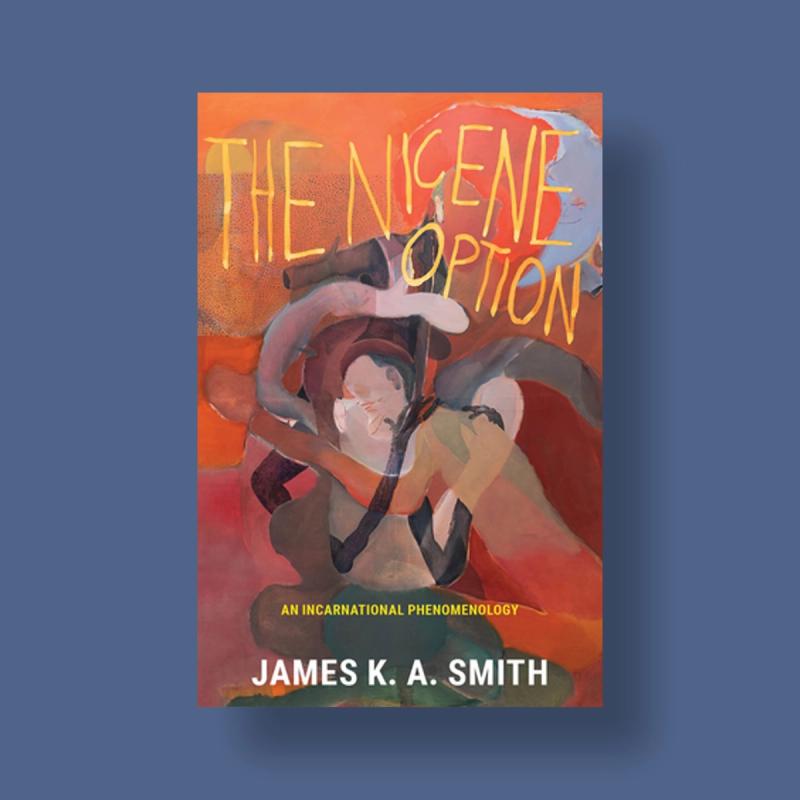***
Baylor University Press | 2021 | 253 pages (hardcover) | $44.99
James K. A. Smith’s readership has surged in recent years through accessible books, such as You Are What You Love: The Spiritual Power of Habit (Brazos Press, 2016). You Are What You Love argues persuasively for Christian discipleship focused on habits, virtues, and rituals. Physical embodiment saturates Smith’s recommendations and links his older works to his newest, The Nicene Option: An Incarnational Phenomenology. This work, Smith explains, provides deeper justification for what he has written on a popular level, with an invitation to “a new depth of reflection” (8). “This book . . . could be read as the extended footnote. . . . In a sense, this book is meant to ‘show the work,’ so to speak—to provide a glimpse of the more careful analyses underlying the claims in my books for wider audiences” (8).
Through the centuries, philosophers have debated the relationship between words and reality. Can signs, even words, represent reality (res) without in some way compromising or distorting the reality? Is there any union between sign and signifier? Can there be a link that avoids reducing one to the other (179)? The Nicene Option claims that the incarnation of the Son of God guides us here. The immense and eternal Son of God, who cannot be contained or reduced to a human body, nevertheless became flesh. He is truly present in the flesh without being reduced to humanity.
At stake “is the possibility of revelation and incarnation” (183). Smith suggests “an account of language analogous to the Incarnation itself, which is a mode of manifestation that both makes God present to the immanence of human perception but also retains the transcendence of the Wholly Other” (175).
If all this sounds academic, it is. The Nicene Option is not for the faint of heart because it engages the notoriously dense world of continental philosophy.
A core challenge in continental philosophy has been to account for alterity and difference: How can we know the Other? How can we encounter that which transcends us without folding the Other into our sphere of perception, thereby reducing alterity to the sphere of the same? (236)
The Nicene Option thus builds on centuries of dialogue among figures, such as Ferdinand de Saussure (“The bond between the signifier and the signified is arbitrary”), Nietzsche, Heidegger, Kant, and Gadamer, among others. Smith focuses his efforts on more recent philosophers, such as Derrida, Husserl, Levinas, Marion, and Charles Taylor. Readers should come prepared, as Smith assumes a basic familiarity with these figures. This is no Philosophy of Religion 101.
Furthermore, The Nicene Option presents an incarnational phenomenology. Phenomenology is a branch of philosophy that emphasizes embodiment and personal knowing. It considers the subject—that we are not simply disembodied knowers but flesh-and-blood people with biases and various situations that shape how we approach the world. The first words of Smith’s afterword are quite striking: “There is no philosophical standpoint that is not, at bottom, confessional. Despite the pretension of Enlightenment claims, there is no neutral, objective, ‘pure’ reason” (235).
The first few chapters present Smith’s outline of “an Incarnational Continental Philosophy of Religion,” and the bulk of the book is devoted to the second major theme: “the Possibility of a Christian Phenomenology.” In chapter 1, “The Philosophy of Religion Takes Practice: A Methodological Manifesto,” Smith argues for “confessional” philosophy—that we should not be ashamed of our faith commitments. Furthermore, human beings are more than just thinkers; we experience religion not only in propositions but also in liturgical practices. We live out what we know; “understanding is ‘implicit in practice’” (26).
These initial chapters contain practical insights into humanity. In chapter 2, “Secular Liturgies,” Smith makes a compelling case that we are inherently religious creatures (38). This is a profoundly biblical point; we worship either the Creator or the creature (Rom. 1:25). Smith argues for the formative power of religious ritual, and he laments that we have absorbed an anthropology that divorces belief from behavior. He writes, “We become believers through ritual formation—and such formative rituals have the status of ‘liturgies’” (38). It is refreshing to see that philosophy of religion has caught up to what churchgoers have long realized: worship rituals shape us. Our knowing is embodied; we “sing” to know.
If Western philosophy is a footnote to Plato, then it could be argued that Western theology is a footnote to Augustine, especially given recent “retrieval” efforts. Smith engages Augustine extensively, particularly in chapter 8, “Beyond Epistemology,” and chapter 10, “Deconstruction—an Augustinian Science?” Although readers will likely not agree with everything Smith posits, he does make many compelling observations, such as lamenting today’s reductionistic anthropology that focuses so much on knowledge that it neglects the will (154, 167). Relying on Augustine, Smith argues it would be reductionistic to speak of “ethics, justice, and morality as instances of discrete decisions and acts; instead . . . a more persuasive and attentive moral phenomenology needs to see the ethical terrain as one of character, not simply discrete ‘acts’ or ‘decisions’” (167). Thus “a persuasive moral phenomenology needs to provide an account of the formation of the moral subject, and especially the formation of habits (virtues/vices) that then play a significant role in an account of decision-making attentive to these dynamics” (167). This is, in my opinion, part of what the Theological Interpretation of Scripture movement has sought to articulate: we ought to be certain kinds of people (2 Pet. 3:11) who typically grow in faithful churches.
Speaking of theological retrieval, Smith’s ninth chapter may be particularly timely, given recent arguments for a “Christian Platonism” (e.g., Craig A. Carter and Hans Boersma). Smith begins, “Our concern will be the relationship of Christian theology to Platonism. It is a curious phenomenon that, into the twenty-first century, the question of Christian theology’s relationship to Platonism remains an orienting and fundamental theme of reflection” (171). Here, Smith takes on Husserl and brings us back to his incarnational theme: “Husserl leaves us with two (heretical) options,” linguistic Docetism, where signs only seem to present the signified, or linguistic Arianism, where the sign is “reduced to immanence” (184). In contrast, Smith argues for the incarnational analogy: fully God and fully man, sign and signified united together truly.
Surprisingly, Smith ignores modern theologians who have discussed these matters, such as Barth, T. F. Torrance, and Tillich. Various theological loci relate: from the nature of Christ’s presence in the Lord’s Supper to analogical language versus univocal. Sharing Smith’s insistence on embodiment, Torrance, for example, discusses the parallel between the hypostatic union of Christ’s two natures and the relationship between a word and its meaning, a sign and reality behind the sign.[1] Incarnational analogies have been applied to the Scriptures’ dual nature as God’s word and the product of human authors. Just as Smith wants to avoid Docetism and Arianism, so too, as John Webster has stated, we must avoid a scriptural Nestorianism that sees the human word as “only extrinsically related to revelation. . . . The res chooses to present itself in this signum, the biblical text in all its grammatical, literary and historical features.”[2]
The final two chapters of The Nicene Option chiefly interact with Marion and Levinas, taking up two major themes of modern philosophy: the gaze and the gift. Touching again on the signs or words that we use to describe God, Smith considers the very possibility of God-talk. With the second commandment in mind, he asks about the possibility of gazing at God through the signs that are words. Some may find this understanding of the second commandment idiosyncratic: Is there not a difference between a picture and a written or spoken word? But for Levinas, “As in Marion, the image is an idol precisely because of its semiotic failure: it does not point beyond itself” (214). Smith asks, “Can there be a non-idolatrous gaze?” (202). For him, this is a question of our ability to say anything about God without reducing him in some way. Must there be a “kenosis,” an emptying of God to reveal himself through human signs (209)? Smith asks, “Is there not an important difference between domestication and condescension?” (208). The answer may seem like common sense to most Christians (of course, we can speak about God!), but Smith interacts with philosophers and gives a philosopher’s answer. He points us to phenomena: creation and incarnation. Smith argues that creation and the incarnation prove that we can “gaze” (regard, attend) on God because an image does not exhaust the riches of reality: he affirms “a revelation of transcendence which inheres in the image without being reduced to immanence” (222).
Overall, readers should appreciate that Smith thoughtfully engages modern philosophers, even on their own terms, rather than through extensive biblical argumentation, and he deftly argues that the biblical (or “Nicene”) perspective makes sense of the world in a way that philosophy alone cannot. The Nicene Option therefore provides a cogent apologetic. At the same time, due to the nature of a collection of essays and the way Smith presents the material, readers may feel like they are jumping into the middle of a movie. I wished Smith had given a little more history behind each question and how each philosopher fit into the puzzle. Likewise, The Nicene Option is limited by its narrow focus on philosophers. The line between philosophy and theology is thin, and theologians have been discussing the same questions. Theologians arguably have a more difficult task, for they must interact with both philosophers and other theologians. Thus The Nicene Option should be paired with a work like Michael Horton’s Covenant and Eschatology: The Divine Drama (WJK, 2002), which not only dialogues with many of the figures that Smith does but also with theologians who have considered similar questions.
Andrew J. Miller is the pastor of Bethel Reformed Presbyterian Church (OPC) in Fredericksburg, VA.
2. See John Webster, Domain of the Word: Scripture and Theological Reason (New York: Bloomsbury T&T Clark, 2012), 111–12.








